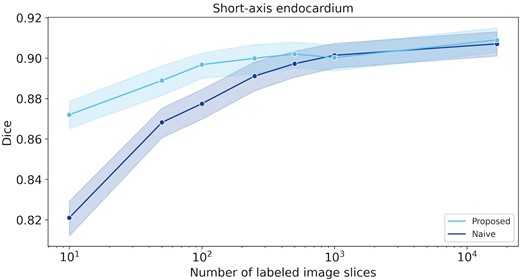-
PDF
- Split View
-
Views
-
Cite
Cite
S Hooper, S Wu, R H Davies, J C Moon, P Kellman, H Xue, C Langlotz, C Re, Speeding up cardiac MR segmentation with semi-supervision: applications in cine imaging, European Heart Journal - Cardiovascular Imaging, Volume 23, Issue Supplement_2, September 2022, jeac141.004, https://doi.org/10.1093/ehjci/jeac141.004
Close - Share Icon Share
Abstract
Type of funding sources: Private company. Main funding source(s): This material is based upon work supported by the Google Cloud Research Credits program with the award GCP19980904.
Segmentation is an important postprocessing step in cardiac magnetic resonance (CMR) imaging that enables quantitative assessment of functional parameters. Deep learning can automate the segmentation process, producing accurate contours of cardiac structures while reducing the time required to analyze images and the interobserver variation compared to manual analysis. However, common approaches to training neural networks (NNs) require large amounts of labeled data, which is costly to generate and slows down the development of CMR segmentation NNs for new applications. Semi-supervision is an approach to alleviate this labeling burden by relying on abundant unlabeled data and a smaller amount of labeled data to train NNs.
We propose a novel semi-supervised method to train CMR segmentation NNs. We use the proposed method to train NNs to segment the left ventricle in CMR cine images. Ultimately, we aim to show that semi-supervision can drastically reduce the amount of labeled data required to develop machine learning segmentation applications for CMR while maintaining high performance.
Our dataset consists of 1,208 short-axis cine CMR images and 1,244 long-axis cine CMR images. An expert annotator manually segmented the endocardium on the end-diastolic and end-systolic short-axis and long-axis images and the epicardium on the end-diastolic short-axis images. We split the dataset randomly by patient into 60% training, 20% validation, and 20% testing data. We train semi-supervised segmentation networks using a supervised cross-entropy loss to learn from the labeled training data and a cosine embedding loss in addition to a pseudo-labeling step to learn from the unlabeled training data. To evaluate how performance changes with different amounts of labeled training data, we vary the percent of training data that has labels from <1%‐100%. We evaluate the predicted segmentation masks using the Dice coefficient.
Using only 100 labeled image slices, the semi-supervised segmentation NNs achieve a mean Dice coefficient within 1.10% of networks trained with fully labeled training sets, corresponding to >85% reduction in required labeled training data (Table 1). The proposed semi-supervised method improves performance over naïve training by 6.21% for the most limited labeled data setting (i.e., 10 labeled image slices; Figure 1).





